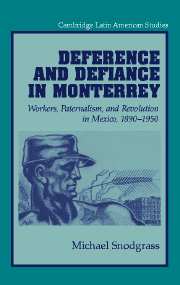Book contents
- Frontmatter
- Contents
- Acknowledgments
- Introduction
- 1 Porfirian Progress in “Mexico's Chicago”
- 2 Revolution Comes to Monterrey
- 3 Work, Gender, and Paternalism at the Cuauhtémoc Brewery
- 4 Making Steel and Forging Men at the Fundidora
- 5 The Democratic Principles of Our Revolution: Labor Movements and Labor Law in the 1920s
- 6 Every Class Has Its Leaders: ASARCO, The Great Depression, and Popular Protest in Monterrey
- 7 Stay with the Company or Go with the Reds
- 8 State Your Position!: Conservatives, Communists, and Cardenismo
- 9 The Quotas of Power: Organized Labor and the Politics of Consensus
- 10 The Persistence of Paternalism
- 11 The Institutionalized Revolution
- Select Bibliography of Primary Sources
- Index
2 - Revolution Comes to Monterrey
Published online by Cambridge University Press: 19 August 2009
- Frontmatter
- Contents
- Acknowledgments
- Introduction
- 1 Porfirian Progress in “Mexico's Chicago”
- 2 Revolution Comes to Monterrey
- 3 Work, Gender, and Paternalism at the Cuauhtémoc Brewery
- 4 Making Steel and Forging Men at the Fundidora
- 5 The Democratic Principles of Our Revolution: Labor Movements and Labor Law in the 1920s
- 6 Every Class Has Its Leaders: ASARCO, The Great Depression, and Popular Protest in Monterrey
- 7 Stay with the Company or Go with the Reds
- 8 State Your Position!: Conservatives, Communists, and Cardenismo
- 9 The Quotas of Power: Organized Labor and the Politics of Consensus
- 10 The Persistence of Paternalism
- 11 The Institutionalized Revolution
- Select Bibliography of Primary Sources
- Index
Summary
The Mexican Revolution began as an armed rebellion meant to overthrow the dictatorship of Porfirio Díaz. The Díaz government fell quickly and, in 1911, Francisco Madero became Mexico's first freely elected president in generations. But his 1913 assassination by counterrevolutionary forces unleashed a civil war that would ultimately cost an estimated one million lives. The revolutionary insurgency concluded four years later with the emergence of what promised to be a new political order. The 1917 Constitution became a blueprint for the revolutionary government's designs to forge a new Mexico though social, economic, and cultural reforms that both built upon and diverged radically from Porfirian precedents. The revolutionary government faced an immediate quandary. Years of political upheaval had recast popular consciousness and galvanized demands for far-reaching reforms in the countryside and cities of Mexico. But the civil war also devastated the economy. The federal government therefore instituted policies of national reconstruction while also addressing the basic social issues that led so many peasants, workers, and middleclass Mexicans to support the revolutionary movement. Labor became a key issue on its agenda. Indeed the emergence of an organized labor movement became one of the earliest and most consequential outcomes of the revolution. The years that followed saw the government court working-class support while attempting to rein in the sort of militancy that might damage Mexico's unstable economy.
- Type
- Chapter
- Information
- Deference and Defiance in MonterreyWorkers, Paternalism, and Revolution in Mexico, 1890–1950, pp. 31 - 53Publisher: Cambridge University PressPrint publication year: 2003



